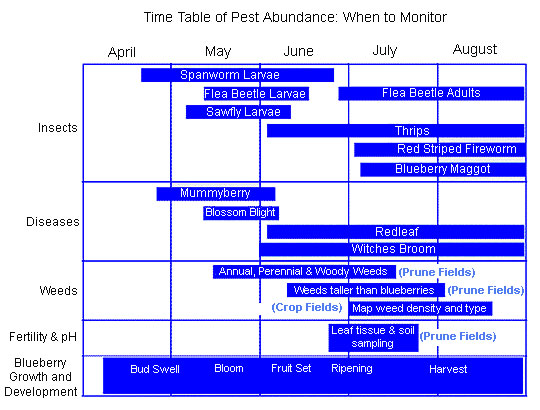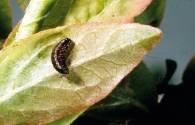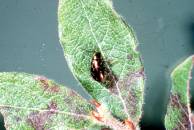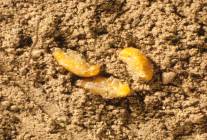200-Blueberry Flea Beetle (Altica sylvia Malloch)
Fact Sheet No. 200, UMaine Extension No. 2372
Prepared by Judith A. Collins, Assistant Scientist, and H. Y. Forsythe, Jr., Professor of Entomology, in cooperation with David Yarborough, Extension Blueberry Specialist, 1995. Updated by Lily Calderwood, Extension Wild Blueberry Specialist, 2020.
Description
The immature flea beetle is a black larva, 3/8-inch long when fully grown (Photo 1). The adult beetle is oval-shaped, shiny, coppery bronze, and less than 1/4-inch long (Photo 2). A common characteristic of flea beetle adults is their ability to jump suddenly when disturbed.
Pupae, which are rarely seen, are small, yellow-orange (Photo 3), and are found about 1/2-inch deep in the soil of blueberry fields.
Life Cycle
The blueberry flea beetle spends the winter as an egg in the litter near the base of the blueberry plants. Soon after the blueberry plants begin to develop in the spring (about mid-May), the eggs hatch and larvae start feeding on the foliage. The last larvae finish feeding in late June, and fully grown larvae move into the soil, where they remain as pupae. Adults begin to emerge in about two weeks and continue feeding on blueberry plants through late summer. Eggs are laid in July and August.
- Photo 1: Larva
- Photo 2: Adult
- Photo 3: Pupae
- Photo 4: Damage
Damage and Economic Importance
Infestations of blueberry flea beetle may be confined to isolated areas or damage may be widespread. Large numbers of flea beetles may completely defoliate large areas in both crop and pruned fields. Damaged leaves have a scalloped appearance around the edges (Photo 4).
Flea beetle larvae feed on blueberry leaves and blossoms from mid-May through June; the adults feed on foliage beginning in late June or early July.
How to Scout for Insects Using a Sweep Net
The sampling procedure to use for most insects (spanworm, flea beetle, sawfly, etc.) involves a single sweep of a 12-inch diameter net from one side of the body to the other (180 degrees). One sample is ten sweeps. While walking through the field, keep two hands on the handle and sweep the foliage. Do not take more than one sweep for every step, and be sure the net penetrates the foliage. After taking ten sweeps, shake everything into the bottom of the net. Empty the contents into a tray, box or other container, and count the number of insects of each species. Write down the results.
Number of samples: Take at least one set of ten sweeps every 100 to 200 feet. The number of sets of 10 sweeps (samples) should be about 10 to 20 for fields of 1 to 10 acres, 20 to 30 samples for fields of greater than 10 acres and less than 50 acres, and 30 samples for fields greater than 50 acres. Include weedy and rocky areas, field edges and “dips” or “hollows” in your sample; insects are commonly found in these areas. While walking to the next sample site, look around and note anything unusual, such as malformed or brown leaves; check these areas closely. Make notes or draw a map so that areas with suspected infestations can be located at a later date. Watch for defoliated areas within crop fields or delayed emergence of blueberry stems in pruned fields. However, do not automatically assume any area with no foliage has been damaged by an insect. Look for the evidence of feeding (chewed leaves and stems) and/or the presence of insects.
I have a 15 inch sweep net. Will that change the threshold I’m looking for?
The short answer is no. You can use either a 12 inch or 15 inch sweep net that has a “muslin” or cloth bag. Newly hatched span worm is one insect that will slip through the larger holes in a mesh net. Some sweep net suppliers include Bioquip, Forestry Suppliers, and Great Lakes IPM. Dr. Frank Drummond developed thresholds based upon a 12-inch sweep net, which is what you will find on the insect factsheets. When using a 15-inch sweep net, you do take a larger swath in a 180º sweep and therefore the relative abundance of the pest will be a bit different. A 12-inch sweep net has a 36 inch arc in each sweep, which is an approximate volume of 2034 sq inches of blueberry stems. A 15 inch sweep net will sweep a volume of 2543 sq. inches. Therefore, the 15-inch sweep net captures 1.25 times the volume of the 12-inch net.
For example, if your threshold is 10 caterpillars per set of 10 sweeps with a 12-inch sweep net, your threshold with a 15-inch sweep net would be 12.5 caterpillars per 10 sweeps. This is a very small difference that can be ignored especially because the threshold 15-inch net threshold is slightly more conservative, erring toward a safer estimate of pest pressure.
Management
Scout your prune and crop fields mid May through early bloom for defoliation and larvae in the sweep net. Threshold levels for the larvae are 30-50 larvae per 10 sweeps. Remembering to scout for flea beetle in prune fields in mid-May is difficult because all of our attention is on the blooming or about to bloom crop fields. However it is never pleasant to find a section of a field defoliated in early June after it is too late to take management action (Figure 1).
Large larvae found in the sweep net, is an indication that some larvae have already dropped to the soil to pupate and you are too late in managing the population this season. Once you find large larvae and defoliated patches, the majority of the population is “safe” in the soil and will avoid your spray application. If you find smaller larvae beginning to feed before or at early bloom, you still have time to spray.
Conventionally, Delegate or Assail is recommended for control. Imidan is also an option. A biological control for blueberry flea beetle adults is the fungus, Beauveria bassiana, sold as Botanigard ES. The adults are less susceptible than are the larvae and we recommended spraying this in the late afternoon or evening. Entrust 80 W (organic formulation of spinosyn) can also be used for adult flea beetle control. For effective control, a spray should be applied as soon as possible after sweeping the field to catch as many larvae as possible. We do not recommend spraying when adult beetles are present because they are very mobile and may leave the field and disperse to adjacent fields without being sprayed. Where adults occur in high numbers, record the location and monitor these locations the following spring and use larval control tactics if the fields warrant it in the spring. Check the Insecticide Chart and pesticide labels for specific instructions.
As production practices shifted from burning to mowing, flea beetle became a bigger problem. Spot burning is still a viable method of control. Burning will kill blueberry flea beetle eggs.

Figure 1. Blueberry flea beetle damage in a crop field in late May, early June. Photo credit: Nicholas Lindholm.
Information in this publication is provided purely for educational purposes. No responsibility is assumed for any problems associated with the use of products or services mentioned. No endorsement of products or companies is intended, nor is criticism of unnamed products or companies implied.
© 2020
Call 800.287.0274 (in Maine), or 207.581.3188, for information on publications and program offerings from University of Maine Cooperative Extension or visit extension.umaine.edu.
The University of Maine is an EEO/AA employer, and does not discriminate on the grounds of race, color, religion, sex, sexual orientation, transgender status, gender expression, national origin, citizenship status, age, disability, genetic information or veteran’s status in employment, education, and all other programs and activities. The following person has been designated to handle inquiries regarding non-discrimination policies: Director of Equal Opportunity, 101 Boudreau Hall, University of Maine, Orono, ME 04469-5754, 207.581.1226, TTY 711 (Maine Relay System).




